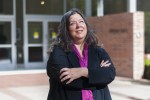On the Day of the Dead each year, Charlene Villaseñor Black goes to the cemetery with her family to reconnect with her ancestors. She then goes to the Hill to see through the Day of the Dead celebration, watching participants and guests create altars in honor of friends and family who have died.
Residents of Sproul Hall wave and smile back at Black each day as she walks past the dorm rooms on the second-floor Chican@/Latin@ Studies theme community, which she brought to Sproul Hall five years ago when she was a faculty-in-residence there.
Black, an art history professor who now lives in De Neve Holly and specializes in Chicana/o art, has dedicated her time to educating students on the Hill about Chicana/o and Latina/o culture by organizing cultural events and programs on the floor.
Throughout her career, she said she has met many students on the Hill who feel uncomfortable with what they say is a lack of ethnic diversity at UCLA. She said she suggested the Sproul Hall second floor be Chicana/o-themed because she lived there from 2011-2013 with her son, who is now in high school.
Black teaches art history of colonial Mexico and a graduate seminar on religious art in a global Hispanic world. Many of her students said they look up to her as both a professor and an adviser because she inspires them to embrace their ethnic backgrounds and to enjoy learning more about cultural arts.
Carlos Rivas, a graduate student in Latin American art history, worked with Black as his main adviser for his entire graduate school career. He said he views Black as a role model because he thinks there are not enough Chicana/o and Latina/o students in the graduate department, and Black dedicates her work to Chicana/o studies.
“Professor Black has always been an inspiration for me, especially because I often feel like I’m one of the few Latinos in graduate school,” Rivas said.
Black was born in Phoenix, but her maternal grandparents came to the U.S. from Mexico in the 1920s and were among the first people detained for a year at the detention center in Laredo, Texas. She said her family background and modern Chicana/o history, such as the events leading to her grandparents’ detainment, inspires her research in Chicana/o studies.
Black said she loves performing and visual arts, and she originally studied classical music as an undergraduate student. But she said she was dissatisfied with studying music alone, and wanted to learn about other subjects related to her ethnic background.
As a graduate student at the University of Michigan in 1995, she developed her interest in Chicana/o studies. However, at all of the institutes she attended, she said it was difficult to find programs that focused on Chicana/o art. She said the rarity of the subject made her determined to teach Chicana/o art history and make it more accessible to others.
“Throughout my academic career, I did not see myself or my culture being reflected in what I was learning, and I had only one Chicano professor in college, so I often felt ethnically isolated,” she said. “I actually sometimes still feel this way as a professor and I am hoping to change that for other students.”
She came to Los Angeles when she was offered a job at UCLA. Upon her arrival, she looked into the city’s exhibitions, shows and museums and found a widespread interest in Chicana/o art. At UCLA, however, she said she was disappointed because she did not feel that she saw the same diversity and prevalence of Chicana/o culture.
“I thought UCLA was a great institute from which I could branch out the study of Chicano art history and, overall, spread diversity and interests in Chicano culture,” Black said.
For the spring issue of Aztlán: A Journal of Chicano Studies, Black edited the section on Chicana/o art of the 21st century. She is currently editing and completing a book coming out this month on Chicana/o art, written by UCLA alumna Shifra Goldman, who died in 2011. Goldman was known for her work on the history of modern Mexican art and as an anti-Vietnam War activist.
Black often collaborates with Steven Loza, a Sproul Cove and Landing faculty-in-residence and professor of ethnomusicology, in organizing Chicana/o- and Latino-themed cultural events on the floor. While Black focuses on the artistic aspects of Chicana/o and Latina/o culture for the events, Loza plays the trumpet to add cultural music.
“The point of these events is to not only give Chicano (and) Latino students at UCLA a sense of solidarity and pride, but also to stimulate non-Chicano students to enjoy learning about new cultures and to encourage mutual acceptance among all students of different ethnicities,” Black said.
Loza said he thinks Black’s work and research are essential in teaching the UCLA community more about the historical aspects of Chicana/o and Latina/o culture.
Black is currently working to organize an annual Cinco de Mayo weeklong celebration to commemorate the historic battles between Mexico and France.

Unblocked Games
Unblocked Games
:PP